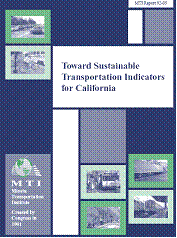- 408-924-7560
- mineta-institute@sjsu.edu
- Donate
Toward Sustainable Transportation Indicators for California
Indicators are an increasingly popular way to present information about a community, region, or agency. As is true for most statistical measures, indicators are descriptive by their nature. This report focuses primarily on sustainable transportation indicators (STI).
Despite the proliferation of indicators - and the proliferation of interest in indicators - there have been only very few and scattered attempts to develop comprehensive sustainability indicators for transportation systems. None have been built from the measures and indicators already collected by local and regional transportation agencies in California. This research addresses that gap, devising and testing sustainable transportation indicators that may be effective and practicable in California. In so doing, it builds on both recent research and practice in the U.S., Canada, and Europe. In addition to an extensive review of the literature, a two-stage survey of transportation professionals and several case studies (three in California plus one of Switzerland) are used to assess the current status of sustainable transportation indicators. The key conclusion is that while there is substantial interest in STI, and much data relevant to STI is being collected, more time and more collaboration between transportation agencies and citizen groups are needed before STIs will be embedded in the decision-making process of local transportation agencies.
DR. RICHARD W. LEE
Principal Investigator and author Dr. Richard W. Lee, AICP, lives in Berkeley, California. He has researched, consulted, and taught courses on urban and regional transportation issues for more than two decades. For the duration of this project he was on the faculty of City and Regional Planning at California Polytechnic University at San Luis Obispo (Cal Poly). He holds a BA in History from Carleton College , as well as a M.S. in Transportation Engineering, a Master of City Planning and a PhD in City and Regional Planning from the University of California, Berkeley. Dr. Lee is a member of the American Institute of Certified Planners, American Planning Association, and the Chartered Institute of Transport. He has also served as a Senior Lecturer and Manager for the Graduate Diploma in Transport Planning Program, School of Resource and Environmental Planning, Massey University, New Zealand (1995-1998).
PAUL WACK, MPA, AICP
Research Associate Paul Wack, AICP, is an Associate Professor of City and Regional Planning at California Polytechnic University at San Luis Obispo (Cal Poly). He holds a BA degree in geography from San Fernando Valley State College, a MA in Urban Geography/Urban Studies from California State University , Northridge, and a Master of Public Administration (with planning management emphasis) from the University of Southern California. He is a member of the American Institute of Certified Planners, and
has served on the Santa Barbara County Planning Commission.
-
Contact Us
San José State University One Washington Square, San Jose, CA 95192 Phone: 408-924-7560 Email: mineta-institute@sjsu.edu






